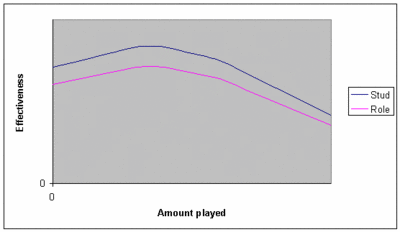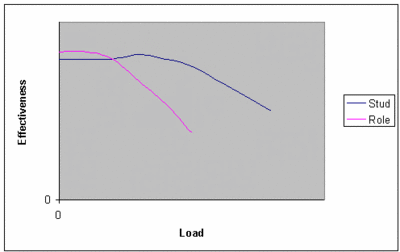In the "Sprinting" post, two teammates referred very cryptically to events where I lost focus during practice. More correctly, I threw a nutty. I've played against guys for 15 years who have never seen me do this, but it can happen. So, without further ado, here are some of my nutties over the years:
1. In 2002, back when Wicks wasn't so old and over the hill that he had to stop playing, we were doing one of his college-boy endzone drills that I had last done in 1988.
A subplot to this was that Alex and I had both been saying for years that the "sprint from the back of the stack to the only possible place that you could cut" cut was bad for endzone offense as it was often well-defended and it took forever to materialize, and that quick cuts from the front of the endzone were more in line with our basic offense (and, as Idris would note, were the kind of cuts that we each preferred to make). So, not only did we have to do a drill, but we had to do a stupid college drill that taught bad ultimate, and we had to keep doing it until we completed 20 in a row. (I'm not sure of the details of it any more, so I might have one or more inaccuracies from here.) We kept turning it over (I don't even think there was defense involved) and kept going back to 0. Finally, after yet another miscue (I might even have been involved in it), I just grunted angrily and walked off the field and sat on the bench about 40 yards away and stewed while the TOs kept on coming. Eventually Jeff Brown wandered over to ask me please to return to the drill for the team's sake. I refused. He persuaded me to walk _towards_ the drill and watch it from the back of the endzone, and I grudgingly accepted.
I wasn't a very good teammate that year.
2. Let's go to the email archives for this one from fall 2001 (also, I note that I had broken a blood vessel in my eye at the track that Tuesday from squinting in anguish so hard):
I went ballistic at practice Thursday night. There has been an increased emphasis on "hard" marking lately, with no distinction made between legitimate aggressive marking and lazy hacking aggressive marking. I said my piece earlier in the year about "let's not cheat, please" and said I didn't need to keep saying it. On Thursday, though, both teams were lazily or deliberately fouling an awful lot on the mark. After one near-tackle on one of my O teammates, an injured D player on the sideline shouted out encouragement to the fouler, and I couldn't take it anymore. I tore off my shirt and started to walk off the field, saying I couldn't take this bullshit anymore and I'm sick of this cheating. Someone said that the O was fouling too, and I agreed that both fuckin' teams were bullshit. Someone pointed out that there had been a request from the O to get some tighter marks so we could get used to it, and we only had 7 players, so I put my shirt back on and resumed playing. But I made short work of my defender, caught both goals (we were playing double score), then had a hearty spike into the ground. I was still pretty fired up the rest of the practice.
No one said a word to me about it, but first thing Saturday at practice, Nathan clarified what he meant by aggressive marking, I thanked him and added that there has been no distinction from the sideline between good marking and sloppy marking.
3. Nationals 2002, pool play against Furious. Again, from the archives, edited for protection:
I was covered for most of the Furious games by Ricky Melner, who had previously played with Oregon, Sockeye, and BoG. He had a very late hit on me in the 1997 finals, when I jumped straight up and had practically landed when he got there with his bid. Gewirtz had fouled Seeger and contested, then did a quick, quiet tap-in which only I heard, being a few yards away. I therefore cut up the line, Seeger threw the floater, and I caught it in the endzone before being taken out. I got up and screamed "You fucking asshole" before realizing I couldn't breathe and collapsing again on the ground. Meanwhile, both teams are gathering around the Seeger/Gewirtz argument, perhaps when Jeremy called Jon a name for the cheap tap-in. Only Bim runs over to me, asks me if I'm again, I nod and mutter "Wind," to which Bim says "Ok, good" and trots over to join the discussion.
So, on the first point of _this_ game, they play a transition D and Ricky ends up covering Cogan. On a tight pass in the endzone, Ricky sorta tackles Dan and I yell, "Nice fuckin' cheap play again," "again" referring to the above play. After the point, I say, "I'm sorry, I'm still mad about that play five years ago", and Ricky knows immediatly what I'm talking about. Anyway, over the course of this game and the semis, he fouls me repeatedly on the mark and while cutting, and I call him "cheater," "fuckin' cheater", "mother fucker", and probably one or two related terms.
---
Umm, please disregard the above paragraph when viewing other things I write about how to behave on the field.
4. Gewirtz, once or twice, maybe more. In 1990, while they're drubbing us, he drops a pass and I begin sprinting for the fast break, and he kicks the disc. I think I tell him that he has fouled me more than the rest of ultimate combined, which may have been true at the time. Then in 1992 semis, I run at him to force him into an error, then sidestep him, only to have him lean into me and sprawl back while calling foul (or call foul while sprawling back). Instead of a goal, it's a foul (amazingly upheld by the observer), and we turn it over.
Jim: Jonny :: moth: flame. I've hated him and made my peace with him a couple times. I don't remember where we stand now. He's a dad, I'm a dad, I offered to help him get his kids to the field before our quarters game last year. I had an extremely odd and interesting conversation with him at Tuneup once (overheard by a dozen people sitting on the line next to us) where he talked about crazy people he grew up with and living on a kibbutz and his past.
5. Indoor soccer, that fat clumsy guy who took me out once and was cheating non-stop the way that soccer players try to do, except that he wasn't any good so he just came across as an ass. More f-bombs and screams and threats and uncontrolled anger. I think I blogged about this earlier this year.
6. Steve Frombach, senior year of college. He pledged our frat, lots of people didn't like him, I didn't necessarily like him either but I went out of my way to defend him for some reason, he depledged and then pledged a neighboring frat. I ran into him at a party at the other frat, and he went out of his way to be an ass. I said, "Steve, I'm above you" and walked away to stew. After a few minutes, I just couldn't take it any more, and went and found him and said, "you know what, I'm not above you" and pushed him. People stepped in and calmed things down, but later, a fellow frat member said that with how mad I was, he was scared because there was only him and one other guy between me and Steve.

